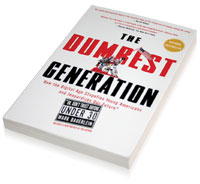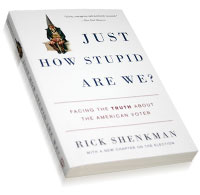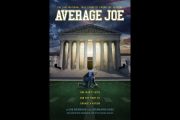
Free-Range Kids: Giving Our Children the Freedom We Had Without Going Nuts With Worry, by Lenore Skenazy, Jossey-Bass Publishers (a Wiley Imprint): San Francisco, Calif., 2009, 256 pages, hardcover, $24.99. The Dumbest Generation: How the Digital Age Stupefies Young Americans and Jeopardizes Our Future (Or, Don’t Trust Anyone Under 30), by Mark Bauerlein, Penguin Publishers: New York, 2009, 270 pages, paperback, $15.95. Just How Stupid Are We? Facing the Truth About the American Voter, by Rick Shenkman, Basic Books (Perseus Book Group): New York, 2009, 242 pages, paperback, $14.95.
Over the past three years, a rash of books by fed-up parents and educators (should we call them “reactionaries”?) have captured our attention. They run the gamut of what psychiatrists no doubt consider “anger issues”: fury over media-induced fear-mongering; outrage at special-interest groups’ obsession with safety, resulting in parental harassment; indignation at an educational system that dumps the three R’s for social goals; and rage against an advertising industry that markets too many electronic gadgets to youngsters, leaving them no time to study or even sleep. The three books named above are but a sampling of the offerings, all of them excellent reads in their own way, with dozens more appearing on websites like Amazon whenever one enters a related title into the engine’s search box.
The most compelling, and entertaining, of the three examples above is Free-Range Kids by Lenore Skenazy. Skenazy was named “the worst mom in America” after she penned a 2008 column proudly proclaiming she had allowed her nine-year-old son to ride a New York City subway by himself in 2008. Fortunately, she was already a commentator for mainstream media giant National Public Radio; otherwise, it is doubtful that her book would ever have hit the street. She might even have faced Child Protective Service agencies for her heresy.
Free-Range Kids is a hilarious, but sobering, look at the ridiculous accumulation of fears thrust upon a gullible and browbeaten generation of parents — and, by extension, upon their “captive” kids. Skenazy’s basic thesis is that we have sucked the joy out of childhood and driven kids to cocoon among their electronic gadgetry. By our refusal to “let kids be kids,” they are thoroughly dependent beings, with little hope for self-determination.
The list of things a child “can’t” do anymore is staggering indeed: walk unaccompanied (“cars!”), play in the park (“perverts!”), explore in the woods (“ticks!”), goof around in the water (“drowning!”), amuse themselves in the dirt (“dirt!”). You get the picture. The author notes that 70 percent of mothers say they played outside when they were children, often unsupervised, but that only 31 percent of their own kids do so today. Skenazy opines:
“Any risk is [deemed] too much risk.”
“Kids do not need a security detail every time they go outside.”
“We are too worried about exceedingly unlikely disasters.”
“We must get over fear of letting our children fail.”
This is just a smattering of Skenazy’s common-sense wisdom. But psychologists insist there is no such thing as “common sense,” and therein lies a possible answer to the author’s question: “Where did all this fear come from?”
The author takes aim at “helpful” parenting articles, at TV news and dramas, at lawmakers who scare parents by threatening dire repercussions for perceived “negligence,” at the cultural phenomenon of overworked parents who don’t even know who their neighbors are, and at marketing campaigns that promote way too many “safety” products.
Not that the author is a “free-to-be” permissive or anti-safety parent; she has nothing but praise for seat belts, car seats, bicycle helmets, and parental leadership. But “safety,” she says, has taken an obsessive turn: knee pads for toddlers learning to walk; entire TV news segments devoted to the plastic hardener, BPA, prevalent in “sippy cups” (when rodents were given megadoses of the substance, they croaked, but toddlers “are not shooting up BPA,” Skenazy counters); articles by “experts” belittling moms who can’t breastfeed their babies and insisting that prolonged breastfeeding makes for better parent-child “bonding” and heightened immunity for their babies. Hogwash, says Skenazy, and besides, store-bought varieties tend to provide much-needed vitamin D, which breast milk often lacks.
Parents take all these imperatives to heart, until the business of childrearing becomes a source of anxiety, not a pleasure to be savored. Parents not only won’t put experts’ pronouncements in perspective, they feel compelled not to.
What Skenazy doesn’t mention is that because average moms lack a degree in behavioral science, the phalanx of “experts” that increasingly makes up the Nanny State considers them incompetent. Thus, the combination of draconian regulations and surreptitious surveillance, under the guise of home visitations (by “nurses” and “social workers”), mandatory parenting classes, and questionnaires.
Parents who feel intimidated unwittingly provide advertisers with license to exploit their fears with ever more “safety” devices, while news and entertainment executives promote increasingly frightful and licentious wares to a population desperate for both distraction and direction.
Skenazy reminds readers: “When we watch TV, we have to remind ourselves that its job is to terrify and disgust us so that we’ll keep watching in horror.” As an NPR commentator, journalist-trained, she ought to know.
The author relates how child experts have parents so uptight that they even demand pediatricians perform MRIs on children whose potty training is not coming along, er, swimmingly. And we won’t even discuss the pressure placed on teachers to give A’s just for showing up on time.
Citing data from the Crimes Against Children Research Center, Skenazy insists that there are no more perverts today than in the 1970s-1990s. Here her argument becomes a bit dicey, although she is probably right that parents should not obsess over it. She allows that life today is not as safe as in the 1950s (when, she doesn’t add, individuals who even “flashed” in the presence of children were put away instead of coddled). The author missed an opportunity to hold television, educators, and Internet service providers accountable for sexual obsession via commercials, graphic sex education, sadomasochistic video games, “normalization” of AIDS, news and TV dramas detailing sexual gymnastics, and tolerance of “hooker-chic” clothes in school. It is hardly surprising that many now-grown youth of the 1970s and ’80s are not only addicted to sex, but lurking in playgrounds and schoolyards. It is the author’s point that cellphones, together with a little guidance from parents regarding anything that seems “off,” are a more sensible strategy against child abduction than keeping kids in a virtual cage or scaring them senseless.
Skenazy’s bottom line? “Not every little thing you do has that much impact on your child’s development.”
Back when parents were proud to be adults, we somehow knew that.
Making Morons
 Which leads to a slightly different take on many of the same issues: Mark Bauerlein’s The Dumbest Generation. Given that a “responsible” parent is supposed to forbid a child to ride public transportation, play outside, go swimming, or memorize the Gettysburg Address, what’s left? The Internet, TV, video games, “sexting,” and all manner of gadget-fixation. Bauerlein cites some grim statistics, including one finding that a full 45 percent of Americans cannot comprehend a ballot.
Which leads to a slightly different take on many of the same issues: Mark Bauerlein’s The Dumbest Generation. Given that a “responsible” parent is supposed to forbid a child to ride public transportation, play outside, go swimming, or memorize the Gettysburg Address, what’s left? The Internet, TV, video games, “sexting,” and all manner of gadget-fixation. Bauerlein cites some grim statistics, including one finding that a full 45 percent of Americans cannot comprehend a ballot.
Bauerlein is by no means alone in his concern that the Digital Age is compromising young Americans’ ability to learn and think logically, thereby jeopardizing America’s future by regurgitating what are essentially canned sound-bites to life’s dilemmas. Forget paragraphs: even words are reduced to one- to three-letter abbreviations, making what we once knew as rational debate — something with a beginning, a middle, and a conclusion — a rare event. If the classics were way beyond the capabilities of most 9th-12th graders when this author taught those grades between 1969 and 1979, they are doubly so now, along with the Civil War, math theorems, and basic science.
Bauerlein hints, but doesn’t exactly say, that today’s youth are easy marks for misrepresented information, which they take for reality, even though, technically, they could easily check questionable facts on the Internet without necessarily having to walk (gasp, alone?) to the library.
An English professor at Emory University, Bauerlein sees the results daily. He makes his case beginning with late-night TV mogul Jay Leno, in a weekly segment called “Jaywalking.” In it, 20- and 30-somethings on the streets of Los Angeles botch the answers to easy questions.
Bauerlein convincingly confirms the lack of any basic store of common knowledge — a first in 200 years of American history. He challenges the reader to imagine all the things one must do in order not to know, for example, what was important in the year 1776, or who the British Prime Minister is, or what the Fifth Amendment means. First, says the author, one would have to forget all the lessons supposedly learned in school — e.g., history, government, English, philosophy, art history, etc. — and, second, one would have to be oblivious to “current events, elections, foreign policy and war.”
But somehow he misses the fact (perhaps because he is a college professor) that K-12 institutions haven’t been emphasizing the above subjects and lessons for some time. Proper English has been traded for street language; history is rarely called anything other than social studies (with the emphasis on “social”); and philosophy and art history are virtually unknown in K-12 settings. So, by the time he sees these kids in college, they are far removed from their parents’ and grandparents’ school experiences. Digital gadgetry fills the void in intellectual stimulation and the emotional void of playground give-and-take, but Bauerlein misses both connections in his book.
In citing a smorgasbord of established surveys proving a dearth of common knowledge, Bauerlein also misses the point that many of the originators and perpetuators of these surveys are the very experts that helped create the problem — the National Education Association and the National Assessment of Educational Progress’ Governing Board being cases in point. When Archie LaPointe and Willard Wirtz coauthored a working paper in 1981, “Measuring the Quality of Education,” for the National Institute of Education (then a sub-agency of the U.S. Department of Education) advising that K-12 education should be shifted away from excellence and toward functionality, immediately followed by the then-much ballyhooed self-esteem movement, which began attacking competition and casting a pall over anything seen as favoring Western thought, these events, taken together, launched the very Dumbest Generation that Bauerlein deplores. The dumbing-down process has even reached the point where it has become fashionable among youngsters to appear stupid. Good grades are deemed “un-cool.”
But are today’s offspring really stupid? Bauerlein may have an advanced degree in English, but does he “get” the fact that K-12 schools have lowered standards radically and routinely pass poor-achieving students undeserving of advancement? Does he not see that the ability to hack a computer system, create “Napster” software, and program a cellphone without directions speaks to a certain kind of intelligence — all of which, by the way, is considered exceedingly “cool” by kids?
What such aptitudes do not produce is a population capable of maintaining a free society.
As entertaining and compelling as Professor Bauerlein’s thesis is, there is arguably not much he can provide in the way of a remedy as long as teacher education and K-12 institutions relegate schools to glorified day-care status, where the only imperative is “collective spirit” (i.e., being popular), as opposed to substantive learning.
 A Dose of the New Adults
A Dose of the New Adults
Which brings us to Rick Shenkman’s book, Just How Stupid Are We? Facing the Truth About the American Voter.
Shenkman is editor and founder of George Mason University’s History News Network. Like Bauerlein, he pulls no punches in accusing “We, the People,” of being “grossly ignorant of the basic facts involving the most important issues we face.” Worse, he says, we don’t seem to want to know the truth; we would rather believe any myth, no matter how far-fetched: “Millions of Americans simply cannot fathom the twists and turns that complicated debates take.” And that, he says, provides politicians and the news media a free pass to oversimplify issues to the point where there are no facts or rationales left to debate, only rabid emotionalism.
Shenkman complains that Americans value personality over intelligent responses during televised debates (where could they have learned that?), and accuses Sarah Palin of sounding like something out of the old sitcom Hee Haw. He opines that voters don’t get it when Palin dodges questions and changes the subject, whereas Joe Biden, he says, gives thoughtful responses and Katie Couric is “a hard-news journalist.”
His point is well-taken, of course, that it isn’t so much that all politicians are miserable cads who fool the public, but that voters have allowed them to get away with it and haven’t demanded better. But does he really view Biden or Couric as not engaging in public deception? More importantly, what do you believe? No matter how you might answer that question, we all should be careful not to automatically believe whatever we hear (including from the media) and to strive to discover the truth.
The three books, taken together, inadvertently highlight a central theme: dependency, a desire to have others make the hard choices of life. Childhood was once a time for intense study; of insatiable curiosity; of play, successes, and failures tempered via the guidance of real grown-ups, not Big Buddies. Youngsters learned to apply propriety, self-discipline, and common sense to their quest for the brass ring of adulthood. Unfortunately, the emerging Nanny State usurped all that by prohibiting parents from doing their job; relegating schools to “keeping kids occupied”; and generally creating a bread-and-circuses environment for America’s Peter Pan populace.



